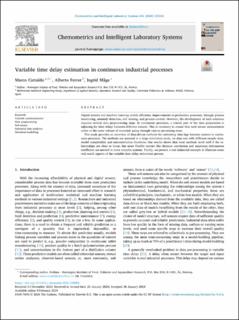| dc.contributor.author | Cattaldo, Marco | |
| dc.contributor.author | Ferrer, Alberto | |
| dc.contributor.author | Måge, Ingrid | |
| dc.date.accessioned | 2024-03-05T08:26:09Z | |
| dc.date.available | 2024-03-05T08:26:09Z | |
| dc.date.created | 2024-02-26T09:39:41Z | |
| dc.date.issued | 2024 | |
| dc.identifier.citation | Chemometrics and Intelligent Laboratory Systems. 2024, 246 1-14. | en_US |
| dc.identifier.issn | 0169-7439 | |
| dc.identifier.uri | https://hdl.handle.net/11250/3121006 | |
| dc.description.abstract | Digital sensors and machine learning enable efficiency improvements in production processes, through process monitoring, anomaly detection, soft sensing, and process control. However, the development of such solutions requires several data preprocessing steps. In continuous processes, a crucial part of the data preparation is adjusting for time delays between different sensors. This is necessary to ensure that each sensor measurement relate to the same volume of materials going through various processing steps. This study provides an overview of data-driven methods for estimating time lags between sensors in continuous processes. The methods are assessed in a large simulation study, on data sets with different sample sizes, model complexities and autocorrelation functions. Our results shows that most methods work well if the relationships are close to linear, but more flexible metrics like distance correlation and maximum information coefficient are needed in more complex systems. Finally, we present a real industrial example to illustrate some real-world aspects of the variable time delay estimation process. | |
| dc.language.iso | eng | en_US |
| dc.title | Variable time delay estimation in continuous industrial processes | en_US |
| dc.title.alternative | Variable time delay estimation in continuous industrial processes | en_US |
| dc.type | Journal article | en_US |
| dc.type | Peer reviewed | en_US |
| dc.description.version | publishedVersion | |
| dc.description.version | publishedVersion | |
| dc.source.pagenumber | 1-14 | en_US |
| dc.source.volume | 246 | en_US |
| dc.source.journal | Chemometrics and Intelligent Laboratory Systems | en_US |
| dc.identifier.doi | 10.1016/j.chemolab.2024.105082 | |
| dc.identifier.cristin | 2249633 | |
| dc.relation.project | Norges forskningsråd: 31411 | |
| dc.relation.project | Nofima AS: 202102 | |
| dc.relation.project | Norges forskningsråd: 309259 | |
| dc.relation.project | Nofima AS: 13247 | |
| cristin.ispublished | true | |
| cristin.fulltext | original | |
| cristin.fulltext | original | |
| cristin.qualitycode | 1 | |
